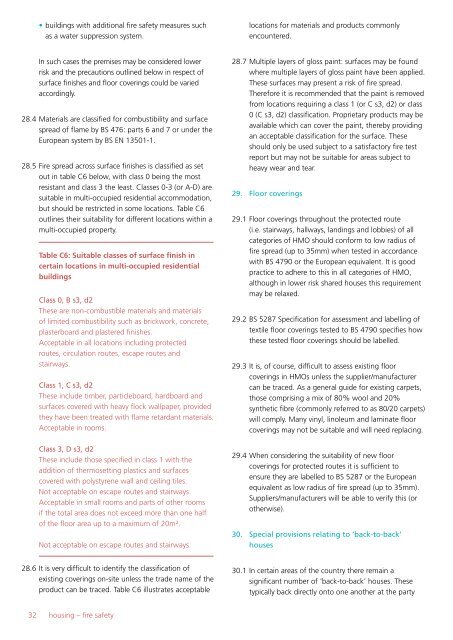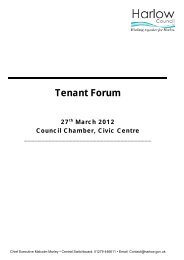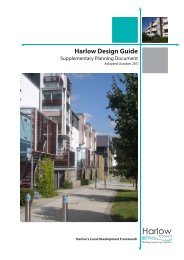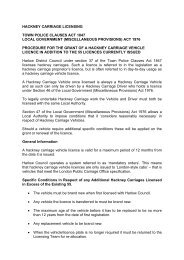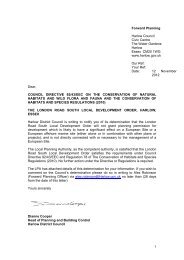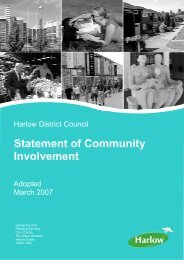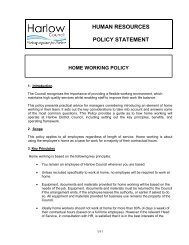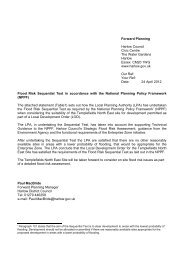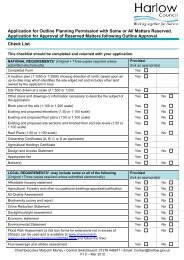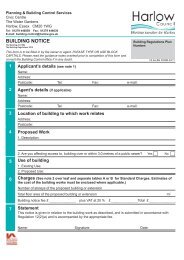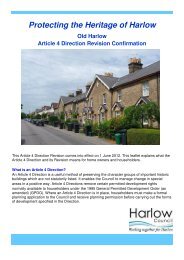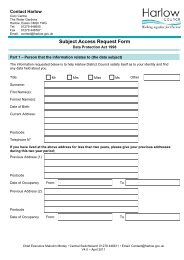HMO fire safety guidance - Harlow Council
HMO fire safety guidance - Harlow Council
HMO fire safety guidance - Harlow Council
You also want an ePaper? Increase the reach of your titles
YUMPU automatically turns print PDFs into web optimized ePapers that Google loves.
• buildings with additional <strong>fire</strong> <strong>safety</strong> measures such<br />
as a water suppression system.<br />
locations for materials and products commonly<br />
encountered.<br />
In such cases the premises may be considered lower<br />
risk and the precautions outlined below in respect of<br />
surface finishes and floor coverings could be varied<br />
accordingly.<br />
28.4 Materials are classified for combustibility and surface<br />
spread of flame by BS 476: parts 6 and 7 or under the<br />
European system by BS EN 13501-1.<br />
28.5 Fire spread across surface finishes is classified as set<br />
out in table C6 below, with class 0 being the most<br />
resistant and class 3 the least. Classes 0-3 (or A-D) are<br />
suitable in multi-occupied residential accommodation,<br />
but should be restricted in some locations. Table C6<br />
outlines their suitability for different locations within a<br />
multi-occupied property.<br />
Table C6: Suitable classes of surface finish in<br />
certain locations in multi-occupied residential<br />
buildings<br />
Class 0, B s3, d2<br />
These are non-combustible materials and materials<br />
of limited combustibility such as brickwork, concrete,<br />
plasterboard and plastered finishes.<br />
Acceptable in all locations including protected<br />
routes, circulation routes, escape routes and<br />
stairways.<br />
Class 1, C s3, d2<br />
These include timber, particleboard, hardboard and<br />
surfaces covered with heavy flock wallpaper, provided<br />
they have been treated with flame retardant materials.<br />
Acceptable in rooms.<br />
Class 3, D s3, d2<br />
These include those specified in class 1 with the<br />
addition of thermosetting plastics and surfaces<br />
covered with polystyrene wall and ceiling tiles.<br />
Not acceptable on escape routes and stairways.<br />
Acceptable in small rooms and parts of other rooms<br />
if the total area does not exceed more than one half<br />
of the floor area up to a maximum of 20m².<br />
Not acceptable on escape routes and stairways.<br />
28.7 Multiple layers of gloss paint: surfaces may be found<br />
where multiple layers of gloss paint have been applied.<br />
These surfaces may present a risk of <strong>fire</strong> spread.<br />
Therefore it is recommended that the paint is removed<br />
from locations requiring a class 1 (or C s3, d2) or class<br />
0 (C s3, d2) classification. Proprietary products may be<br />
available which can cover the paint, thereby providing<br />
an acceptable classification for the surface. These<br />
should only be used subject to a satisfactory <strong>fire</strong> test<br />
report but may not be suitable for areas subject to<br />
heavy wear and tear.<br />
29. Floor coverings<br />
29.1 Floor coverings throughout the protected route<br />
(i.e. stairways, hallways, landings and lobbies) of all<br />
categories of <strong>HMO</strong> should conform to low radius of<br />
<strong>fire</strong> spread (up to 35mm) when tested in accordance<br />
with BS 4790 or the European equivalent. It is good<br />
practice to adhere to this in all categories of <strong>HMO</strong>,<br />
although in lower risk shared houses this requirement<br />
may be relaxed.<br />
29.2 BS 5287 Specification for assessment and labelling of<br />
textile floor coverings tested to BS 4790 specifies how<br />
these tested floor coverings should be labelled.<br />
29.3 It is, of course, difficult to assess existing floor<br />
coverings in <strong>HMO</strong>s unless the supplier/manufacturer<br />
can be traced. As a general guide for existing carpets,<br />
those comprising a mix of 80% wool and 20%<br />
synthetic fibre (commonly referred to as 80/20 carpets)<br />
will comply. Many vinyl, linoleum and laminate floor<br />
coverings may not be suitable and will need replacing.<br />
29.4 When considering the suitability of new floor<br />
coverings for protected routes it is sufficient to<br />
ensure they are labelled to BS 5287 or the European<br />
equivalent as low radius of <strong>fire</strong> spread (up to 35mm).<br />
Suppliers/manufacturers will be able to verify this (or<br />
otherwise).<br />
30. Special provisions relating to ‘back-to-back’<br />
houses<br />
28.6 It is very difficult to identify the classification of<br />
existing coverings on-site unless the trade name of the<br />
product can be traced. Table C6 illustrates acceptable<br />
30.1 In certain areas of the country there remain a<br />
significant number of ‘back-to-back’ houses. These<br />
typically back directly onto one another at the party<br />
32<br />
housing – <strong>fire</strong> <strong>safety</strong>


